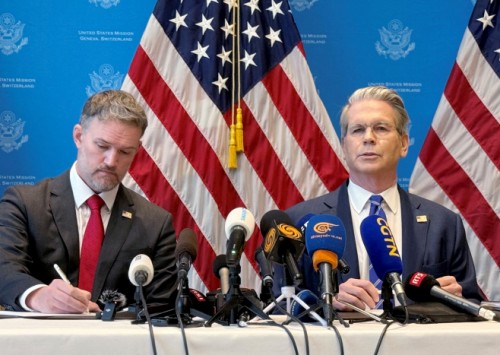 |
| U.S. Treasury Secretary Scott Bessent (right) and Jamieson Greer, U.S. Trade Representative, hold a press conference in Geneva, Switzerland, on May 12 to discuss the outcome of recent trade negotiations between the United States and China. / Reuters-Yonhap News |
The United States and China announced a joint statement on May 12 after three days of negotiations in Geneva, Switzerland, agreeing to each cut their respective tariffs by 115 percentage points. The agreement marks a significant de-escalation in the ongoing trade war between the world's two largest economies.
Under the deal, the Trump administration’s additional tariffs on Chinese imports will drop from 145% to 30%, while China’s retaliatory tariffs on U.S. goods will fall from 125% to 10%. The new rates will take effect on May 14 and remain in place for 90 days while the two sides work toward a final trade agreement—one that may be announced during a summit between President Donald Trump and Chinese President Xi Jinping, potentially setting the stage for a dramatic diplomatic moment.
The new 30% U.S. tariff reflects a combination of punitive measures imposed by President Trump earlier this year: two separate 10% hikes in February and March in response to China’s alleged inaction on fentanyl exports, and a baseline 10% tariff applied broadly on April 2 to most trading partners. However, analysts from Citigroup and Macquarie cited by The Wall Street Journal estimate the effective post-deal U.S. tariff rate on Chinese goods remains around 39%, accounting for partial exemptions—still well above the pre-Trump average of 11%.
China’s revised 10% tariff reflects a 115-point reduction from its previous 125% retaliatory duties, directly matching the U.S. rollback. In addition to lowering tariffs, China agreed to suspend or cancel its non-tariff retaliatory measures. These could include lifting restrictions on rare earth mineral exports—crucial for advanced technology and battery production—according to The Wall Street Journal.
U.S. Treasury Secretary Scott Bessent clarified that this deal does not affect existing sector-specific tariffs, such as the 25% duties on cars, steel, and aluminum that apply to all trade partners.
Bessent also expressed hope that the two nations could address trade imbalances through increased Chinese purchases of U.S. goods, although currency issues were reportedly not discussed during the talks.
“Neither side wants decoupling,” Bessent emphasized, referring to a broader economic split between the two powers. Jamieson Greer, U.S. Trade Representative, added that escalating the trade war further would amount to an embargo. “Such a scenario is not sustainable for either side,” he warned.
Most Read
-
1
-
2
-
3
-
4
-
5
-
6
-
7





















